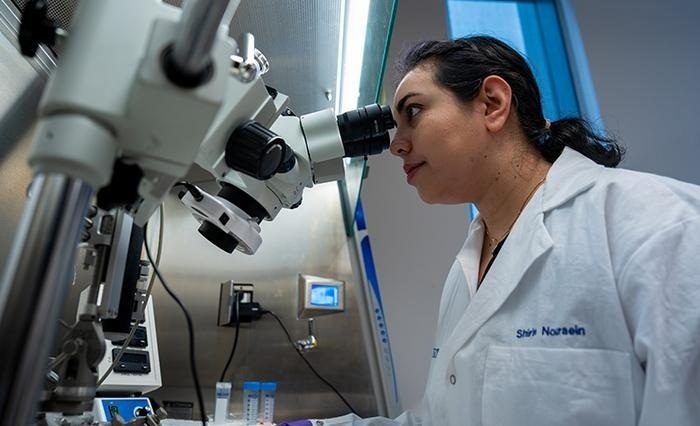DNA Hypermethylation Assay Confirms Negative Prostate Cancer Biopsy Results
|
By LabMedica International staff writers Posted on 10 Jun 2014 |

Image: ConfirmMDx detects an epigenetic field effect or “halo” associated with the cancerization process at the DNA level in cells adjacent to cancer foci. This epigenetic “halo” around a cancer lesion can be present despite having a normal appearance under the microscope (Photo courtesy of MDxHealth).
A commercially available assay that measures the level of hypermethylated DNA in tissue samples was found to accurately identify negative-for-cancer prostate tissues in more than 88% of cases.
Approximately 700,000 men in the USA receive a negative prostate biopsy result; however approximately 25% of these results are false-negative. Under the current standard of care, prostate biopsy procedures collect 10–12 needle biopsy cores on average, effectively sampling less than 1% of a man’s prostate. This approach leaves men at risk of occult cancer, leading to a high rate of repeat biopsies, often on cancer-free men. The MDxHealth (Herstal, Belgium) "ConfirmMDx for Prostate Cancer" assay addresses the unmet medical need for a clinically effective diagnostic test to address this dilemma. "ConfirmMDx for Prostate Cancer" is an epigenetic assay to help distinguish patients who have a true-negative biopsy from those who may have occult cancer. The test helps urologists rule-out prostate cancer-free men from undergoing unnecessary repeat biopsies and, helps rule-in high risk patients who may require repeat biopsies and potential treatment.
In a study to validate the use of the MDxHealth assay, investigators at Johns Hopkins University (Baltimore, MD, USA) evaluated archived negative-for-cancer prostate biopsy core tissue samples from 350 subjects from five urologic centers in the USA. All subjects underwent a repeat biopsy within 24 months with a negative (controls) or positive (cases) histopathological result. The MDxHealth assay profiled methylation levels for the known tumor suppressor genes GSTP1, APC, and RASSF1, which are silenced by hypermethylation and fail to block cancer development.
Results of analysis of the two biopsy specimens from each patient showed that average levels of APC and RASSF1 were about twice as high in the 92 subjects whose second biopsies yielded positive results, as compared to the 228 with two negative biopsies. For GSTP1, the levels were more than eight times higher in the cancerous biopsies.
“Overall, if there is an absence of methylation in all three biomarkers, there is an 88% likelihood you do not have cancer,” said senior author Dr. Jonathan Epstein, professor of pathology, urology, and oncology at Johns Hopkins University. “The test is not 100% of an assurance, but it is a major step forward.”
“Often, one biopsy is not enough to definitively rule out prostate cancer,” said Dr. Epstein. “Our research finds that by looking for the presence or absence of cancer in a different way, we may be able to offer many men peace of mind without putting them through the pain, bleeding and risk of infection that can come with a repeat biopsy. It turns out as many as 20% of men have prostate cancer, even if their first biopsy results are negative. Approximately 40% of men with a negative biopsy go on to receive a second biopsy. Many high-risk men fear sampling errors in their initial biopsy, which often leads to a high rate of follow-up procedures to merely confirm the absence of the disease.”
The study was published in the April 16, 2014, online edition of the Journal of Urology.
Related Links:
MDxHealth
Johns Hopkins University
Approximately 700,000 men in the USA receive a negative prostate biopsy result; however approximately 25% of these results are false-negative. Under the current standard of care, prostate biopsy procedures collect 10–12 needle biopsy cores on average, effectively sampling less than 1% of a man’s prostate. This approach leaves men at risk of occult cancer, leading to a high rate of repeat biopsies, often on cancer-free men. The MDxHealth (Herstal, Belgium) "ConfirmMDx for Prostate Cancer" assay addresses the unmet medical need for a clinically effective diagnostic test to address this dilemma. "ConfirmMDx for Prostate Cancer" is an epigenetic assay to help distinguish patients who have a true-negative biopsy from those who may have occult cancer. The test helps urologists rule-out prostate cancer-free men from undergoing unnecessary repeat biopsies and, helps rule-in high risk patients who may require repeat biopsies and potential treatment.
In a study to validate the use of the MDxHealth assay, investigators at Johns Hopkins University (Baltimore, MD, USA) evaluated archived negative-for-cancer prostate biopsy core tissue samples from 350 subjects from five urologic centers in the USA. All subjects underwent a repeat biopsy within 24 months with a negative (controls) or positive (cases) histopathological result. The MDxHealth assay profiled methylation levels for the known tumor suppressor genes GSTP1, APC, and RASSF1, which are silenced by hypermethylation and fail to block cancer development.
Results of analysis of the two biopsy specimens from each patient showed that average levels of APC and RASSF1 were about twice as high in the 92 subjects whose second biopsies yielded positive results, as compared to the 228 with two negative biopsies. For GSTP1, the levels were more than eight times higher in the cancerous biopsies.
“Overall, if there is an absence of methylation in all three biomarkers, there is an 88% likelihood you do not have cancer,” said senior author Dr. Jonathan Epstein, professor of pathology, urology, and oncology at Johns Hopkins University. “The test is not 100% of an assurance, but it is a major step forward.”
“Often, one biopsy is not enough to definitively rule out prostate cancer,” said Dr. Epstein. “Our research finds that by looking for the presence or absence of cancer in a different way, we may be able to offer many men peace of mind without putting them through the pain, bleeding and risk of infection that can come with a repeat biopsy. It turns out as many as 20% of men have prostate cancer, even if their first biopsy results are negative. Approximately 40% of men with a negative biopsy go on to receive a second biopsy. Many high-risk men fear sampling errors in their initial biopsy, which often leads to a high rate of follow-up procedures to merely confirm the absence of the disease.”
The study was published in the April 16, 2014, online edition of the Journal of Urology.
Related Links:
MDxHealth
Johns Hopkins University
Latest Pathology News
- AI Tool Outperforms Doctors in Spotting Blood Cell Abnormalities
- AI Tool Rapidly Analyzes Complex Cancer Images for Personalized Treatment
- Diagnostic Technology Performs Rapid Biofluid Analysis Using Single Droplet
- Novel Technology Tracks Hidden Cancer Cells Faster
- AI Tool Improves Breast Cancer Detection
- AI Tool Predicts Treatment Success in Rectal Cancer Patients
- Blood Test and Sputum Analysis Predict Acute COPD Exacerbation
- AI Tool to Transform Skin Cancer Detection with Near-Perfect Accuracy
- Unique Immune Signatures Distinguish Rare Autoimmune Condition from Multiple Sclerosis
- Simple Optical Microscopy Method Reveals Hidden Structures in Remarkable Detail
- Hydrogel-Based Technology Isolates Extracellular Vesicles for Early Disease Diagnosis
- AI Tool Improves Accuracy of Skin Cancer Detection
- Highly Sensitive Imaging Technique Detects Myelin Damage
- 3D Genome Mapping Tool to Improve Diagnosis and Treatment of Genetic Diseases
- New Molecular Analysis Tool to Improve Disease Diagnosis
- Tears Offer Noninvasive Alternative for Diagnosing Neurodegenerative Diseases
Channels
Clinical Chemistry
view channel
Chemical Imaging Probe Could Track and Treat Prostate Cancer
Prostate cancer remains a leading cause of illness and death among men, with many patients eventually developing resistance to standard hormone-blocking therapies. These drugs often lose effectiveness... Read more
Mismatch Between Two Common Kidney Function Tests Indicates Serious Health Problems
Creatinine has long been the standard for measuring kidney filtration, while cystatin C — a protein produced by all human cells — has been recommended as a complementary marker because it is influenced... Read moreMolecular Diagnostics
view channel
Genetic Marker to Help Children with T-Cell Leukemia Avoid Unnecessary Chemotherapy
About 400 children in the UK are diagnosed with acute lymphoblastic leukemia (ALL) each year, with roughly 15% presenting with a more aggressive T-ALL subtype. While the standard approach is a four-week... Read more
Four-Gene Blood Test Rules Out Bacterial Lung Infection
Lower respiratory tract infections (LRTIs) are among the most common reasons for antibiotic prescriptions, yet distinguishing bacterial infections from viral ones remains notoriously difficult.... Read more
New PCR Test Improves Diagnostic Accuracy of Bacterial Vaginosis and Candida Vaginitis
Bacterial vaginosis (BV) impacts approximately 25% of women of reproductive age, while up to 75% of women experience candida vaginitis (CV) at least once in their lifetime. Vaginal symptoms are one of... Read moreHematology
view channel
Platelet Activity Blood Test in Middle Age Could Identify Early Alzheimer’s Risk
Early detection of Alzheimer’s disease remains one of the biggest unmet needs in neurology, particularly because the biological changes underlying the disorder begin decades before memory symptoms appear.... Read more
Microvesicles Measurement Could Detect Vascular Injury in Sickle Cell Disease Patients
Assessing disease severity in sickle cell disease (SCD) remains challenging, especially when trying to predict hemolysis, vascular injury, and risk of complications such as vaso-occlusive crises.... Read more
ADLM’s New Coagulation Testing Guidance to Improve Care for Patients on Blood Thinners
Direct oral anticoagulants (DOACs) are one of the most common types of blood thinners. Patients take them to prevent a host of complications that could arise from blood clotting, including stroke, deep... Read moreImmunology
view channel
New Test Distinguishes Vaccine-Induced False Positives from Active HIV Infection
Since HIV was identified in 1983, more than 91 million people have contracted the virus, and over 44 million have died from related causes. Today, nearly 40 million individuals worldwide live with HIV-1,... Read more
Gene Signature Test Predicts Response to Key Breast Cancer Treatment
DK4/6 inhibitors paired with hormone therapy have become a cornerstone treatment for advanced HR+/HER2– breast cancer, slowing tumor growth by blocking key proteins that drive cell division.... Read more
Chip Captures Cancer Cells from Blood to Help Select Right Breast Cancer Treatment
Ductal carcinoma in situ (DCIS) accounts for about a quarter of all breast cancer cases and generally carries a good prognosis. This non-invasive form of the disease may or may not become life-threatening.... Read moreMicrobiology
view channel
Rapid Diagnostic Test Matches Gold Standard for Sepsis Detection
Sepsis kills 11 million people worldwide every year and generates massive healthcare costs. In the USA and Europe alone, sepsis accounts for USD 100 billion in annual hospitalization expenses.... Read moreRapid POC Tuberculosis Test Provides Results Within 15 Minutes
Tuberculosis remains one of the world’s deadliest infectious diseases, and reducing new cases depends on identifying individuals with latent infection before it progresses. Current diagnostic tools often... Read more
Rapid Assay Identifies Bloodstream Infection Pathogens Directly from Patient Samples
Bloodstream infections in sepsis progress quickly and demand rapid, precise diagnosis. Current blood-culture methods often take one to five days to identify the pathogen, leaving clinicians to treat blindly... Read moreTechnology
view channel
Artificial Intelligence Model Could Accelerate Rare Disease Diagnosis
Identifying which genetic variants actually cause disease remains one of the biggest challenges in genomic medicine. Each person carries tens of thousands of DNA changes, yet only a few meaningfully alter... Read more
AI Saliva Sensor Enables Early Detection of Head and Neck Cancer
Early detection of head and neck cancer remains difficult because the disease produces few or no symptoms in its earliest stages, and lesions often lie deep within the head or neck, where biopsy or endoscopy... Read moreIndustry
view channel
Abbott Acquires Cancer-Screening Company Exact Sciences
Abbott (Abbott Park, IL, USA) has entered into a definitive agreement to acquire Exact Sciences (Madison, WI, USA), enabling it to enter and lead in fast-growing cancer diagnostics segments.... Read more





















